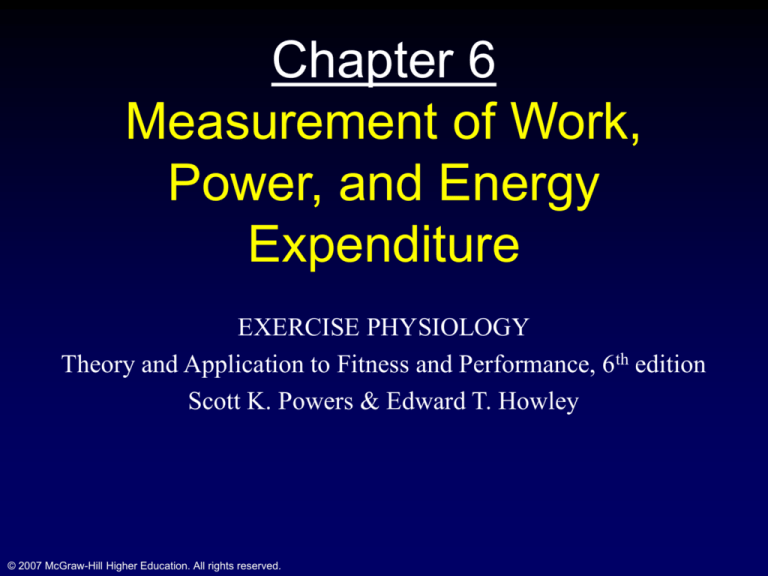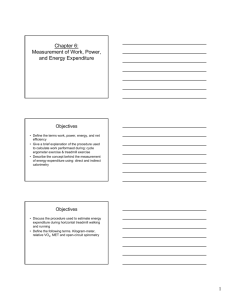
Chapter 6
Measurement of Work,
Power, and Energy
Expenditure
EXERCISE PHYSIOLOGY
Theory and Application to Fitness and Performance, 6th edition
Scott K. Powers & Edward T. Howley
© 2007 McGraw-Hill Higher Education. All rights reserved.
Objectives
• Define the terms work, power, energy, and net
efficiency
• Give a brief explanation of the procedure used
to calculate work performaed during cycle
ergometer exercise and treadmill exercise
• Describe the concept behind the measurement
of energy expenditure using direct and indirect
calorimetry
© 2007 McGraw-Hill Higher Education. All rights reserved.
Objectives
• Discuss the procedure used to estimate energy
expenditure during horizontal treadmill walking
and running
• Define the following terms: kilogram-meter,
relative VO2, MET, and open-circuit spirometry
© 2007 McGraw-Hill Higher Education. All rights reserved.
Units of Measure
• English system used in United States
• Metric system is the standard system of
measurement for scientists
– Used to express mass, length, and volume
• System International units or SI units
– Standardized terms for measurement of:
• Energy
• Force
• Work
• Power
© 2007 McGraw-Hill Higher Education. All rights reserved.
Work
Work is the product of force and distance
Work = force x distance
• Lifting a 5 kg weight up a distance of 2 m
Work = force x distance
Work = 5 kp x 2 m
Work = 10 kpm
Kg – measure of mass, not force
Kp = force acting on a mass of 1 kg at normal gravity
© 2007 McGraw-Hill Higher Education. All rights reserved.
Power
Power is how much work is done per unit of time
Power = work / time
• Performing 2,000 kgm of work in 60 seconds
Power = work/time
Power = 2,000 kgm/60s
Power = 33.3 kgm•s-1
SI Units = 1 Watt (W) = 0.102 kpm•s-1
Power = 326.8 W
© 2007 McGraw-Hill Higher Education. All rights reserved.
Measurement of Work and Power
Bench Step
Work = body weight (kg) x distance/step x
steps/min x min
Work = body weight (kg) x distance (m)
= 70 kp x 150 m
= 10,500 kpm or ~ 103 kilojoules
Power = work minutes
= 10,500 kpm/10 min
= 1,050 kpm/min or 171.6 W
© 2007 McGraw-Hill Higher Education. All rights reserved.
Measurement of Work and Power
Cycle Ergometer
Work = resistance (kg) x (distance/revolution X
revolutions)
Work = force (kg) x distance (m)
= 1.5 kp x (6m/rev x 600 rev)
0 5,400 kpm or 52.97 kilojoules
• Power = work minutes
= 5,400 kpm/10 min
= 540 kpm/min or 88.2 W
© 2007 McGraw-Hill Higher Education. All rights reserved.
Measurement of Work and Power
Treadmill
• Calculation of work performed while a subject
runs or walks on a treadmill is not generally
possible when the treadmill is horizontal.
• Although running horizontal on a treadmill
requires energy
• Work performed during horizontal walking or
running is complicated
• Quantifiable work is being performed when
walking or running up a slope
© 2007 McGraw-Hill Higher Education. All rights reserved.
Determination of Percent
Grade on a Treadmill
Fig 6.2
© 2007 McGraw-Hill Higher Education. All rights reserved.
Measurement of Work and Power
Treadmill
• Incline of the treadmill is expressed in percent
grade
• Percent grade is the amount of vertical rise per
100 units of belt travel
Vertical displacement = % grade x Distance
Treadmill speed = 200m/min
Percent Grade = 7.5% or 0.075
Exercise time = 10 mins
Total vertical distance traveled
= 200m/min X 0.075 x 10 mins
© 2007 McGraw-Hill Higher Education. All rights reserved.
= 150 m
Measurement of Work and Power
Treadmill
Work = body weight (kg) x total vertical distance
traveled
= 70 kp x 150 m
= 10,500 kpm or ~103 kilojoules
Power = work minutes
= 10,500 kpm/10 mins
= 1,050 kpm/min or Watts
© 2007 McGraw-Hill Higher Education. All rights reserved.
Measurement of Energy
Expenditure
• Direct calorimetry
– Measurement of heat production as an
indication of metabolic rate
Foodstuff + O2 ATP + Heat
Cell work
Heat
• Indirect calorimetry
– Measurement of oxygen consumption as
an estimate of resting metabolic rate
Foodstuff + O2 Heat + CO2 + H2O
© 2007 McGraw-Hill Higher Education. All rights reserved.
Open-Circuit Spirometry
Fig 6.4
© 2007 McGraw-Hill Higher Education. All rights reserved.
Estimation of Energy
Expenditure
• Energy cost of horizontal treadmill walking or
running
– O2 requirement increases as a linear
function of speed
• Expression of energy cost in METs
– 1 MET = energy cost at rest
– 1 MET = 3.5 ml•kg-1•min-1
© 2007 McGraw-Hill Higher Education. All rights reserved.
Linear Relationship Between
VO2 and Walking or Running
Speed
Fig 6.5
© 2007 McGraw-Hill Higher Education. All rights reserved.
Calculation of Exercise
Efficiency
• Net efficiency
% net efficiency =
Work output
Energy expended
above rest
• Net efficiency of cycle ergometry
– 15-27%
© 2007 McGraw-Hill Higher Education. All rights reserved.
x 100
Factors That Influence
Exercise Efficiency
• Exercise work rate
– Efficiency decreases as work rate
increases
• Speed of movement
– There is an optimum speed of movement,
and any deviation reduces efficiency
• Fiber composition of muscles
– Higher efficiency in muscles with greater
percentage of slow fibers
© 2007 McGraw-Hill Higher Education. All rights reserved.
Net Efficiency During Arm
Crank Ergometery
Fig 6.8
© 2007 McGraw-Hill Higher Education. All rights reserved.
Relationship Between Energy
Expenditure and Work Rate
Fig 6.9
© 2007 McGraw-Hill Higher Education. All rights reserved.
Effect of Speed of Movement
of Net Efficiency
Fig 6.10
© 2007 McGraw-Hill Higher Education. All rights reserved.
Running Economy
• Not possible to calculate net efficiency of
horizontal running
• Running Economy
– Oxygen cost of running at given speed
– Lower VO2 (ml•kg-1•min-1) indicates better
running economy
• Gender difference in running economy
– No difference at slow speeds
– At “race pace” speeds, males may be more
economical than females
© 2007 McGraw-Hill Higher Education. All rights reserved.
Comparison of Running Economy
Between Males and Females
Fig 6.11
© 2007 McGraw-Hill Higher Education. All rights reserved.
Chapter 6
Measurement of Work, Power, and
Energy Expenditure
© 2007 McGraw-Hill Higher Education. All rights reserved.







